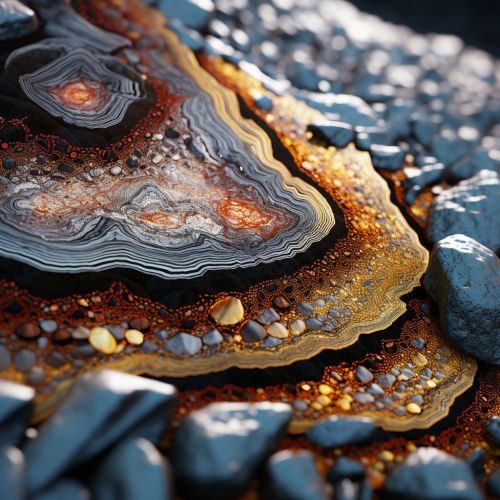Biosignature
Introduction
Biosignatures are measurable phenomena that provide scientific evidence of past or present life. They are often sought in the context of exobiology and astrobiology, where researchers hunt for signs of life in the data returned by spacecraft studying other planets and moons in our solar system. Biosignatures can also be found on Earth, in the geological record, providing evidence of ancient life.


Definition and Types
A biosignature is any substance, structure, or pattern whose origin specifically requires a biological agent. The term is often used in the context of life detection on other planets, where biosignatures might be detected remotely by telescopes or in situ by spacecraft. The search for biosignatures, therefore, is a significant aspect of astrobiology.
Biosignatures can be categorized into several types, including chemical, morphological, and temporal.
Chemical Biosignatures
Chemical biosignatures are substances or sets of substances that can provide evidence of past or present life due to their biological origin. They include biogenic minerals, isotopic ratios, and organic molecules.
Biogenic Minerals
Biogenic minerals are minerals created by biological processes. They can serve as biosignatures if they are uniquely associated with biological activity.
Isotopic Ratios
Certain isotopic ratios can serve as biosignatures. For example, the ratio of carbon-12 to carbon-13 can indicate the presence of life, as biological processes preferentially use the lighter carbon-12 isotope.
Organic Molecules
Certain organic molecules can serve as biosignatures. For example, the presence of complex organic molecules, such as amino acids, can indicate the presence of life.
Morphological Biosignatures
Morphological biosignatures are physical structures or patterns that indicate the presence of life. They include microfossils, stromatolites, and biogenic sediments.
Microfossils
Microfossils are microscopic remains of organisms. They can serve as biosignatures if they exhibit characteristics that are uniquely associated with biological activity.
Stromatolites
Stromatolites are layered sedimentary formations that are formed by the growth of layer upon layer of cyanobacteria, a type of photosynthesizing bacteria. They can serve as biosignatures if they exhibit characteristics that are uniquely associated with biological activity.
Biogenic Sediments
Biogenic sediments are sediments that have been significantly altered by biological activity. They can serve as biosignatures if they exhibit characteristics that are uniquely associated with biological activity.
Temporal Biosignatures
Temporal biosignatures are changes over time that indicate the presence of life. They include changes in atmospheric composition and changes in the isotopic composition of certain elements.
Changes in Atmospheric Composition
Changes in the composition of a planet's atmosphere can serve as a biosignature. For example, the presence of oxygen in Earth's atmosphere is a result of photosynthesis by plants and cyanobacteria.
Changes in Isotopic Composition
Changes in the isotopic composition of certain elements can serve as a biosignature. For example, the ratio of carbon-12 to carbon-13 in Earth's atmosphere has changed over time due to biological activity.
Detection of Biosignatures
The detection of biosignatures is a significant aspect of astrobiology. It involves the search for signs of life in the data returned by spacecraft studying other planets and moons in our solar system, as well as the search for signs of life in the geological record on Earth.
Detection on Other Planets
The search for biosignatures on other planets involves both remote sensing by telescopes and in situ measurements by spacecraft. Remote sensing can detect biosignatures in the atmosphere of a planet, such as the presence of oxygen or methane. In situ measurements can detect biosignatures in the soil or rocks of a planet, such as the presence of biogenic minerals or organic molecules.
Detection on Earth
The detection of biosignatures on Earth involves the study of the geological record. This can include the study of microfossils, stromatolites, and biogenic sediments, as well as the study of changes in the isotopic composition of certain elements over time.
Challenges in Biosignature Detection
There are several challenges in the detection of biosignatures. These include the risk of contamination, the difficulty in distinguishing between biogenic and abiogenic processes, and the possibility of false positives and false negatives.
Risk of Contamination
There is a risk of contamination in the detection of biosignatures, particularly in the context of space exploration. For example, a spacecraft could carry microbes from Earth to another planet, which could then be detected as a false positive for life on that planet.
Distinguishing Between Biogenic and Abiogenic Processes
It can be difficult to distinguish between biogenic and abiogenic processes. For example, certain minerals can be formed by both biological and non-biological processes. Therefore, the presence of these minerals alone cannot be taken as definitive evidence of life.
False Positives and False Negatives
There is a risk of false positives and false negatives in the detection of biosignatures. A false positive is when a non-biological process is incorrectly identified as a biological one. A false negative is when a biological process is not detected.
Conclusion
Biosignatures are a crucial tool in the search for life beyond Earth, as well as in understanding the history of life on our own planet. While the detection of biosignatures presents many challenges, ongoing research and technological advancements continue to improve our ability to identify these signs of life.
See Also
Exobiology Astrobiology Biogenic Minerals Microfossils Stromatolites
